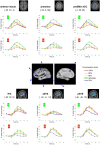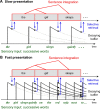A temporal bottleneck in the language comprehension network
- PMID: 22745508
- PMCID: PMC6622343
- DOI: 10.1523/JNEUROSCI.5685-11.2012
A temporal bottleneck in the language comprehension network
Abstract
Humans can understand spoken or written sentences presented at extremely fast rates of ∼400 wpm, far exceeding the normal speech rate (∼150 wpm). How does the brain cope with speeded language? And what processing bottlenecks eventually make language incomprehensible above a certain presentation rate? We used time-resolved fMRI to probe the brain responses to spoken and written sentences presented at five compression rates, ranging from intelligible (60-100% of the natural duration) to challenging (40%) and unintelligible (20%). The results show that cortical areas differ sharply in their activation speed and amplitude. In modality-specific sensory areas, activation varies linearly with stimulus duration. However, a large modality-independent left-hemispheric language network, including the inferior frontal gyrus (pars orbitalis and triangularis) and the superior temporal sulcus, shows a remarkably time-invariant response, followed by a sudden collapse for unintelligible stimuli. Finally, linear and nonlinear responses, reflecting a greater effort as compression increases, are seen at various prefrontal and parietal sites. We show that these profiles fit with a simple model according to which the higher stages of language processing operate at a fixed speed and thus impose a temporal bottleneck on sentence comprehension. At presentation rates faster than this internal processing speed, incoming words must be buffered, and intelligibility vanishes when buffer storage and retrieval operations are saturated. Based on their temporal and amplitude profiles, buffer regions can be identified with the left inferior frontal/anterior insula, precentral cortex, and mesial frontal cortex.
Figures








Similar articles
-
Neural interaction of speech and gesture: differential activations of metaphoric co-verbal gestures.Neuropsychologia. 2009 Jan;47(1):169-79. doi: 10.1016/j.neuropsychologia.2008.08.009. Epub 2008 Aug 14. Neuropsychologia. 2009. PMID: 18771673
-
Neural processing during older adults' comprehension of spoken sentences: age differences in resource allocation and connectivity.Cereb Cortex. 2010 Apr;20(4):773-82. doi: 10.1093/cercor/bhp142. Epub 2009 Aug 7. Cereb Cortex. 2010. PMID: 19666829 Free PMC article.
-
Neural substrates of irony comprehension: A functional MRI study.Brain Res. 2010 Jan 13;1308:114-23. doi: 10.1016/j.brainres.2009.10.030. Epub 2009 Oct 22. Brain Res. 2010. PMID: 19853585
-
Multivariate activation and connectivity patterns discriminate speech intelligibility in Wernicke's, Broca's, and Geschwind's areas.Cereb Cortex. 2013 Jul;23(7):1703-14. doi: 10.1093/cercor/bhs165. Epub 2012 Jun 12. Cereb Cortex. 2013. PMID: 22693339 Free PMC article.
-
The anatomy of language: a review of 100 fMRI studies published in 2009.Ann N Y Acad Sci. 2010 Mar;1191:62-88. doi: 10.1111/j.1749-6632.2010.05444.x. Ann N Y Acad Sci. 2010. PMID: 20392276 Review.
Cited by
-
The Stroop effect involves an excitatory-inhibitory fronto-cerebellar loop.Nat Commun. 2023 Jan 11;14(1):27. doi: 10.1038/s41467-022-35397-w. Nat Commun. 2023. PMID: 36631460 Free PMC article.
-
Broca's Area Is Not a Natural Kind.Trends Cogn Sci. 2020 Apr;24(4):270-284. doi: 10.1016/j.tics.2020.01.001. Epub 2020 Feb 20. Trends Cogn Sci. 2020. PMID: 32160565 Free PMC article. Review.
-
Convergence of spoken and written language processing in the superior temporal sulcus.Neuroimage. 2018 May 1;171:62-74. doi: 10.1016/j.neuroimage.2017.12.068. Epub 2017 Dec 23. Neuroimage. 2018. PMID: 29277646 Free PMC article.
-
Spatiotemporally distributed frontotemporal networks for sentence reading.Proc Natl Acad Sci U S A. 2023 Apr 25;120(17):e2300252120. doi: 10.1073/pnas.2300252120. Epub 2023 Apr 17. Proc Natl Acad Sci U S A. 2023. PMID: 37068244 Free PMC article.
-
Engagement of the speech motor system in challenging speech perception: Activation likelihood estimation meta-analyses.Hum Brain Mapp. 2024 Sep;45(13):e70023. doi: 10.1002/hbm.70023. Hum Brain Mapp. 2024. PMID: 39268584 Free PMC article.
References
-
- Binder JR, Rao SM, Hammeke TA, Frost JA, Bandettini PA, Hyde JS. Effects of stimulus rate on signal response during functional magnetic resonance imaging of auditory cortex. Brain Res Cogn Brain Res. 1994;2:31–38. - PubMed
Publication types
MeSH terms
Substances
LinkOut - more resources
Full Text Sources
Other Literature Sources
Miscellaneous
